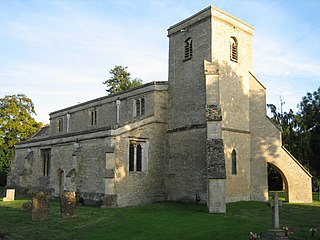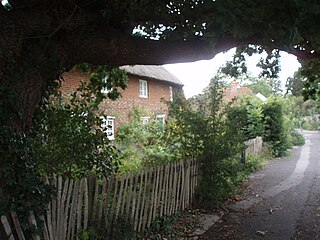
Hayling Island is an island off the south coast of England, in the borough of Havant in the county of Hampshire, east of Portsmouth.

Langstone is a village near Havant, Hampshire in the south east of England in Portsmouth. It has good railway connections to London, Southampton, Portsmouth and Brighton, from the nearby Havant railway station. There are many large gated detached houses on the main road, "Langstone Road" and on the roads surrounding this. It has a sailing club, several architecturally unusual buildings, and several historically significant buildings, including a converted (water) millhouse and a converted 18th century windmill, the latter of which is a local landmark.

Culham is a village and civil parish in a bend of the River Thames, 1 mile (1.6 km) south of Abingdon in Oxfordshire. The parish includes Culham Science Centre and Europa School UK. The parish is bounded by the Thames to the north, west and south, and by present and former field boundaries to the east. It is low-lying and fairly flat, rising from the Thames floodplain in the south to a north-facing escarpment in the north up to 260 feet (80 m) above sea level. The 2011 Census recorded its population as 453.

Chichester Harbour is a large natural harbour in West Sussex and Hampshire. It is situated to the south-west of the city of Chichester and to the north of the Solent. The harbour and surrounding land has been designated as an Area of Outstanding Natural Beauty (AONB) and a biological and geological Site of Special Scientific Interest (SSSI). The area is also part of the Solent Maritime Special Area of Conservation, Chichester and Langstone Harbours Ramsar site, Special Protection Area and Nature Conservation Review site, Grade I. Part of it is a Geological Conservation Review site and two areas are Local Nature Reserves.

Langston was a small station on the Hayling Island branch. The station along with the rest of the line closed in 1963, and it served the Langstone area of Havant, a former village which had become contiguous with the larger town to its north. The railway companies always used the old spelling "Langston" for the station, in spite of this form not being used by the local community, and it can be seen in many photographs of the station sign.

North Hayling station was a halt on the single track Hayling Island branch, most often used to load oysters caught by local fishermen, but also ornithologists and ramblers. The station, along with the line was closed, in 1963. The station was located on the west coast of Hayling Island, very close to the coast. The station was very basic, with a timber concourse and wooden shelter. The station has been demolished and a section of the trackbed is now a footpath.

Osney Abbey or Oseney Abbey, later Osney Cathedral, was a house of Augustinian canons at Osney in Oxfordshire. The site is south of the modern Botley Road, down Mill Street by Osney Cemetery, next to the railway line just south of Oxford station. It was founded as a priory in 1129, becoming an abbey around 1154. It was dissolved in 1539 but was created a cathedral, the last abbot Robert King becoming the first Bishop of Oxford. The see was transferred to the new foundation of Christ Church in 1545 and the building fell into ruin. It was one of the four renowned monastic houses of medieval Oxford, along with St Frideswide's Priory, Rewley and Godstow.

Itchen Abbas is a village and former civil parish, now in the parish of Itchen Valley, in the Winchester district, in the county of Hampshire, England. The village is on the River Itchen about 4 miles (6.4 km) north-east of Winchester.

Launton is a village and civil parish on the eastern outskirts of Bicester, Oxfordshire, England. The 2011 Census recorded the parish's population as 1,204.

Warblington is a suburb of Havant, in the county of Hampshire, England. Warblington used to be a civil parish, and before that was part of the Hundred of Bosmere.

Hayling Island was a station on Hayling Island in southeastern Hampshire, England. It was opened for passengers in 1867 as the terminus of the four and a half mile Hayling Island branch, a single track line from Havant which transported holidaymakers to the resort until its closure in 1963.

Froxfield Green is a village in the civil parish of Froxfield and Privett, in the East Hampshire district of Hampshire, England. It is 3 miles (5 km) north-west of Petersfield, and lies just north of the A272 road.

St Mary's Church is a parish church in the Church of England in the parish of Portsmouth in Hampshire.

The Inter-Service Training and Development Centre (ISTDC) was a department under the British Chiefs of Staff set up prior to World War II for the purpose of developing methods and equipment to use in Combined Operations.

Princess Catherine Alexandrovna Yurievskaya was the natural daughter of Alexander II of Russia by his mistress, Princess Catherine Dolgorukova. In 1880, she was legitimated by her parents' morganatic marriage. In her own family, she was known as Katia.
Warner Hotels is a hospitality company owning 14 country and coastal properties around the UK in North Wales, Somerset, Herefordshire, Berkshire, North Yorkshire, Nottinghamshire, Isle of Wight, Suffolk, Hampshire and Warwickshire. Founded in 1932 as Warner Holiday Camps, later known as Warner Holidays and has been adult only since 1994. In the 1990s Warner's started developing country house hotels and changing their existing 'camps' into coastal resorts and hotels.
The following is a timeline of the history of Barrow-in-Furness, England, United Kingdom.

Mill Rythe Holiday Village is a holiday camp in Hayling Island, Hampshire, England. Originally called Sunshine Holiday Camp, it opened its doors to the public in the early 1940s and had also been used by the Royal Marines during the war and for holidays with their families after World War II.






















